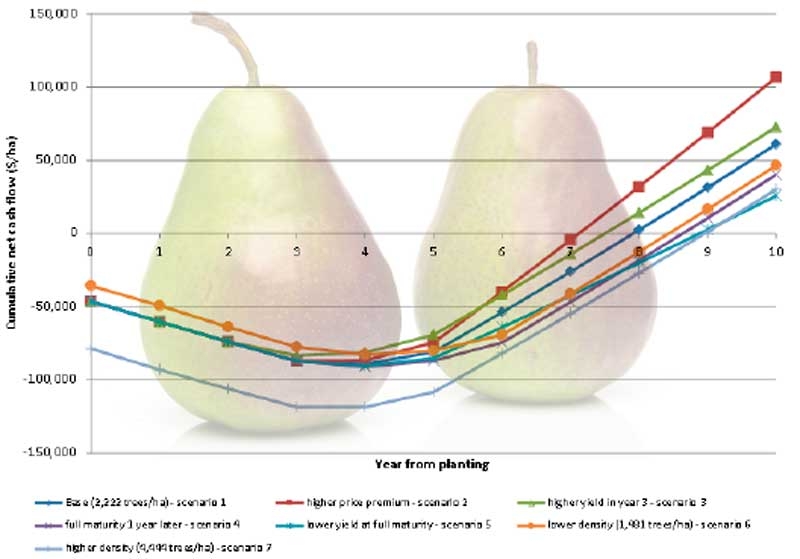Bred out of the Australian National Pear Breeding Program at Agriculture Victoria, Tatura, and marketed by APAL as Deliza®, ANP-0131 is one of the new red-blushed pears that is visually attractive, tastes good, has desirable texture and stores extremely well, providing it with a point of difference on the fresh market.
(continued from last issue)
Results
Based on the assumptions discussed earlier, the ‘economic feasibility’ (or profitability) and the ‘financial feasibility’ (or liquidity) of investing in the new red-blushed pears varies depending on the scenario (Table 1).
The NPV for the ‘Base’ scenario (Scenario 1) for a planting density of 2,222 trees/ha averaged $210,613 over 30 years, in the range $165,888 to $257,175.
The NPV and the lower 90% confidence interval are both greater than zero indicating a profitable investment.
The modified internal rate of return (MIRR) averaged 8.7%, in the range 8.1% to 9.3%.
These results indicate that growers can invest in the new pears with confidence.
Debt peaked at approximately $89,083 in year three, and the investment broke even in year nine.
Sensitivity analysis
Sensitivity analysis (Scenario 2–5 in Table 1) suggested that a 10 percentage-point increase in the price premium, bringing the price up to $990/t net, or an increase in the yield in year three to 10 t/ha would have the most positive effect on both profitability and liquidity, with the pay-back period dropping back to year eight.
In contrast, a delay by one year in achieving full yield potential (Scenario 4) has the most adverse effect on the economic performance metrics.
Should full maturity be delayed by one year, or yield at full maturity fall to 60 t/ha (Scenario 5), then the grower would be better off to plant at a lower tree density (Scenario 6).
The higher density planting of 4,444 trees/ha (Scenario 7) is the least profitable option, and has the highest peak-debt. The reason is that the anticipated yields were insufficient to offset the higher establishment costs.
Although preliminary, the results of this analysis suggest that growing the new red-blushed pears would be a profitable investment for pear growers in areas such as the Goulburn Valley if done in a modern orchard system characterised by high-density plantings of compact trees that use water efficiently, fruit early in life and produce consistent high yields of quality.
See this article, images, tables and graphs in Tree Fruit April 2017






















